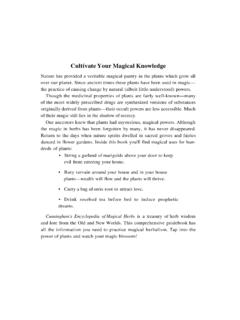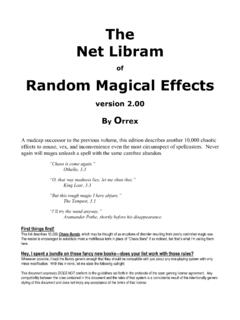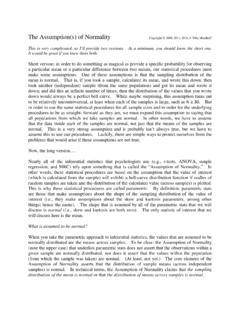Transcription of SUGI 27: Using the Magical Keyword 'INTO:' in PROC SQL
1 Using the Magical Keyword " I N T O: " in P R O C SQ L Thiru Satchi Blue Cross and Blue Shield of Massachusetts, Boston, Massachusetts Abstract INTO: host-variable in proc sql is a powerful tool. It simplifies programming code while minimizing the risk of typographical errors. SQL I NTO: creates one or more macro variables, based on the results of a SEL ECT statement. This macro variable(s) reflects a list of values that can then be used to manipulate data in both DATA and PROC steps. The usefulness of SQL INTO: will be demonstrated by analyzing a large medical claims database.
2 Keywords: INTO:, host-variable, macro, SQL Introduction The INTO: host-variable in proc sql is a valuable resource for creating a macro variable made up of values. It overcomes several limitations in hard coding values, including the possibility of typographical errors, resource constraints, and does not account for dynamic data. Previous presentations have explored the application and utility of this host-variable (1-2). The purpose of this presentation is to review previously covered, as well as to introduce new forms and applications of the INTO: host-variable to address common business needs.
3 Variations of the INTO: Host-Variable Prior to the Release , the INTO: host-variable simply stored the first row of values (3). For example, the host-variable in Listing 1 that refers to the sample data in Listing 2 would store the following: P01 53071. L isting 1. Release form of the I N TO: host-variable. 1. proc sql NOPRINT; 2. SELECT EMPID, DIAG 3. INTO :EMP_LIST, : DIAGLIST 4. FROM MASTER; 5. QUIT; 6. 7. %PUT &EMP_LIST L i sting 2. Sample data. 1. DATA MASTER; 2. INPUT EMPID $3. DIAG $5. MEMID 9.; 3. CARDS; 4. P01 53071 258766 5.
4 P02 99215 92139678 6. P03 99201 921396 7. P04 45355 566511 8. P05 45383 464467896 9. P06 43260 87932 10. P07 99213 73771 11. P08 45380 846420987 12. P09 88714 346987 13. P10 55431 3469871 14. ; However with this release, multiple rows of values can now be stored. In Listing 3a, each row of values is stored in separate macro variables (Listing 3b). In addition, a dash (-) or the keywords THROUGH or THRU can be used to denote a range of macro variables.
5 And the Keyword DISTI NCT is used to generate a unique list of values. Listing 3a. Basic Form of the I N T O: Host- Variable (Release ). 1. proc sql NOPRINT; 2. SELECT DISTINCT EMPID, DIAG 3. INTO :E1 - :E4, :D1 - :D3 4. FROM MASTER; 5. QUIT; 6. 7. %PUT 8. %PUT 9. %PUT L i sting 3b. Values Generated in Listing 3a. %PUT &E1 &D1: P01 53071 %PUT &E2 &D2: P02 99215 %PUT &E3 &D3: P03 99201 The INTO: host-variable can also be used to generate lists of values, the value of which has been previously demonstrated (2). These lists can be modified with modifiers (Listing 4a).
6 For example, the SEPERATED BY qualifier indicates how this list of values should be concatenated; in Listing 4a, SUGI 27 Coders' Cornermacro variable E1 , is separated by a comma (results are presented in Listing 4b). Another modifier is QUOTE , which flanks each value with double quotes ( )(Listing 4a, macro variable E2 ; results are presented in Listing 4b). It should be noted that leading and trailing blanks are deleted from the values by default when Using the QUOTE modifier, but NOTRIM can be added to retain these blanks. Values can also be manually concatenating the quotes (Listing 4a, macro variable E3 ; results are presented in Listing 4b).
7 This feature is useful when adapting lists to other systems. For example, the SQ L in the DB2 environment accepts single quotes, not double quotes. Therefore, we must manually create a list of values separated by a single quote, because of the QUOT E modifier (see reference 2). Listing 4a. V ariations of the I N T O: Host- Variable (Release ). 1. proc sql NOPRINT; 2. SELECT DISTINCT EMPID, 3. QUOTE(EMPID), 4. || (EMPID) || , 5. MEMID , 6. MEMID FORMAT 9. 7. 8. INTO :E1 SEPERATED BY , , 9.
8 :E2 SEPERATED BY , , 10. :E3 SEPERATED BY , , 11. :M1 SEPERATED BY , 12. :M2 SEPERATED BY , 13. FROM MASTER; 14. QUIT; 15. 16. %PUT %PUT %PUT 17. %PUT %PUT Listing 4b. Lists of Values Generated in Listing 4a. E1 List: P01,P02,P03,P04,P05,P05,P06,P07,P08,P09, P10 E2 List: P01 , P02 , P03 , P04 , P05 , P06 , P07 , P08 , P09 , P10 E3 List: P01 , P02 , P03 , P04 , P05 , P05 , P06 , P07 , P08 , P09 , P10 M1 List: 258766 92139678 921396 566511 , 87932 73771 , 346987 3469871 M2 List: 258766, 92139678, 921396, 566511, 464467896, 87932, 73771, 846420987, 346987, 3469871 It is important to define numeric values in the S E L E C T statement (Listing 4, macro variable M1 ).
9 If not, variable length will be a maximum of 8 bytes by default. This demonstrated in Listing 4 (macro variable M2 ) as the 9-digit numbers, 846420987 and 464467896 are converted to and , respectively (Listing 4b). It should be noted that SAS will accept a list of numeric variables separated by either a comma or a blank. Application of the INTO: Host-Variable I have presented an overview of the INTO: host-variable. I have previously illustrated the utility in overcoming limitations with the SQL Pass-Through facility (2). I will now demonstrate another application Using the host-variable to generate a list of dummy variables.
10 This is program is similar to that of a previous presentation (1), but it more applicable to health care claims data. Health care claims data contains multiple rows of transactions per patient that varies by the number of services received. It is often necessary to summarize this data which may comprise of millions of rows. For this example, I will focus on summarizing the following variables for the claims data: unique patient ID ( PAT_ID ), treatment group ( TG_GRP ), service date ( SVC_DT ), and paid amount for that service ( PAID-AMT ). Here is an abbreviated sample of medical claims data (taken from Appendix A, Step 1).















